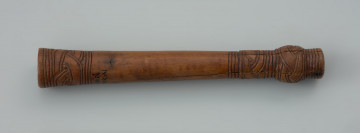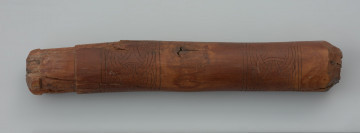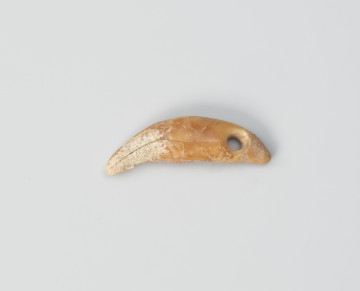
Wooden frame
840 — 980
National Museum in Szczecin
Part of the collection: Middle Ages
The tortoise brooch (fibula) was discovered in 1897 during non-professional archaeological research carried out by H. Meier on a barrow cemetery in Świelubie, in the Dygowo municipality in Kołobrzeg district, West Pomeranian Voivodeship. The necropolis in Świelubie consists of nearly 100 barrows; to date, only 36 graves containing male and female burials have been excavated, which led to the discovery of numerous precious artefacts of Scandinavian origin, including tortoise broochers, which were used for fastening women's robes on their shoulders. The brooch discovered in 1897 was part of the grave goods belonging to a woman buried in a cremation grave. The fibula was cast out of a copper alloy. It is partially damaged, and the pin did not survive to this day. The surface of the fibula is richly ornamented with zoomorphic motifs reminiscent of Scandinavian art of the Borre style, dating back to the late 9th – late 10th centuries. The decorative detail consists of eight fields marked out by crossing ribbons, with seven protrusions marking their intersections. Three of the four preserved zones feature animals gripping the bodies of other creatures with their claws. The next two depict two animals arched at the hips – perhaps they are horses with their heads facing each other. The other two fields contain representations of animal masks linked together by clenched paws.
Grzegorz Durdyń
Other names
cup buckle
Author / creator
Dimensions
cały obiekt: height: 11.3 cm, width: 6.4 cm
Object type
pin (fastener), fibula, adornment
Technique
casting
Material
copper alloy
Origin / acquisition method
acquisition
Creation time / dating
Creation / finding place
Owner
Muzeum Narodowe w Szczecinie
Identification number
Location / status

840 — 980
National Museum in Szczecin

900 — 1100
National Museum in Szczecin

951 — 1050
National Museum in Szczecin
DISCOVER this TOPIC
National Museum in Lublin
DISCOVER this PATH
Educational path